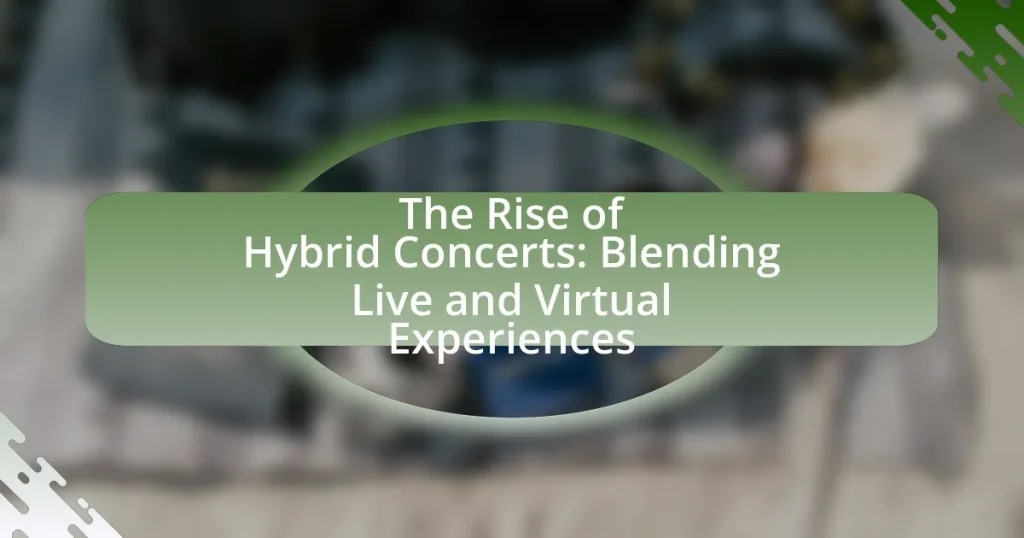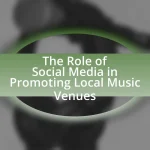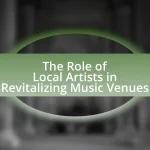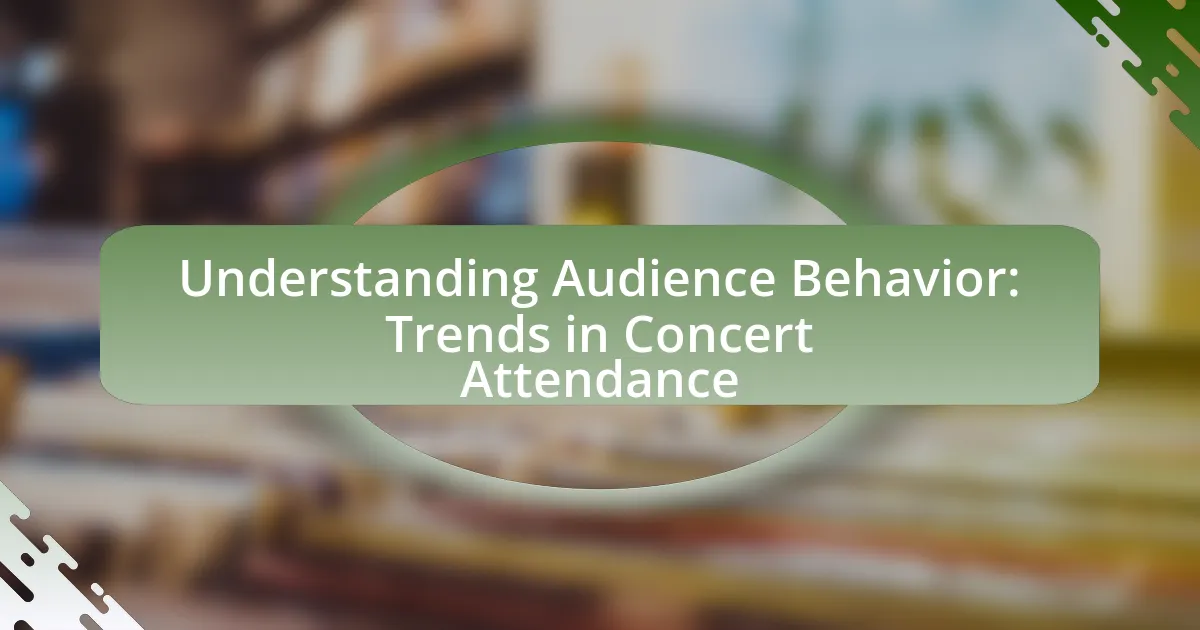Hybrid concerts are events that merge live in-person performances with virtual streaming options, allowing audiences to participate both physically and online. This format is gaining traction due to its ability to reach wider audiences, eliminate geographical barriers, and provide flexibility for attendees. The article explores the differences between hybrid and traditional concerts, the technological advancements enabling this model, and the unique experiences offered to audiences. It also addresses the challenges organizers face, the financial implications, and best practices for successfully implementing hybrid concerts, highlighting the growing trend towards this innovative approach in the live entertainment industry.

What are Hybrid Concerts and Why are They Gaining Popularity?
Hybrid concerts are events that combine live in-person performances with virtual streaming options, allowing audiences to participate both physically and online. They are gaining popularity due to their ability to reach a broader audience, as they eliminate geographical barriers and provide flexibility for attendees. According to a report by Eventbrite, 67% of event organizers believe hybrid events will be the future of live entertainment, highlighting the growing trend towards this format. Additionally, the COVID-19 pandemic accelerated the adoption of hybrid models, as artists and venues sought innovative ways to engage fans while adhering to health guidelines.
How do Hybrid Concerts differ from Traditional Concerts?
Hybrid concerts differ from traditional concerts primarily by incorporating both live in-person attendance and virtual participation through digital platforms. Traditional concerts typically involve a physical audience gathered at a venue, while hybrid concerts allow remote viewers to experience the performance in real-time via streaming technology. This format has gained traction, especially during the COVID-19 pandemic, as it enables artists to reach a broader audience, with reports indicating that hybrid events can increase attendance by up to 50% compared to solely in-person concerts. Additionally, hybrid concerts often utilize interactive features, such as live chats and virtual meet-and-greets, enhancing audience engagement beyond what traditional concerts offer.
What elements are combined in a Hybrid Concert experience?
A Hybrid Concert experience combines live performances with virtual elements, allowing audiences to engage both in-person and online. This format typically includes a physical venue where artists perform live, alongside digital streaming options that enable remote viewers to participate in real-time. The integration of interactive technologies, such as augmented reality and social media engagement, enhances the experience for both live and virtual attendees. This approach has gained popularity, especially during events like the COVID-19 pandemic, where artists and organizers sought innovative ways to reach wider audiences while adhering to safety protocols.
Why are audiences drawn to Hybrid Concerts?
Audiences are drawn to hybrid concerts because they offer a unique blend of live and virtual experiences, catering to diverse preferences and accessibility needs. This format allows fans to enjoy performances in real-time, whether they are physically present at the venue or participating online, thus expanding the reach of artists. According to a report by Eventbrite, 70% of attendees appreciate the flexibility of hybrid events, as they can choose how to engage based on their comfort levels and circumstances. Additionally, hybrid concerts often incorporate interactive elements, such as live chats and social media engagement, enhancing the overall experience and fostering a sense of community among attendees.
What technological advancements have enabled Hybrid Concerts?
Technological advancements that have enabled hybrid concerts include high-speed internet, advanced streaming platforms, and immersive audio-visual technologies. High-speed internet allows for seamless live streaming, ensuring that virtual attendees experience minimal lag and high-quality video. Advanced streaming platforms, such as YouTube Live and Twitch, provide interactive features that engage both in-person and online audiences. Immersive audio-visual technologies, including 360-degree cameras and spatial audio systems, enhance the experience for virtual participants, making them feel as if they are part of the live event. These technologies collectively facilitate the blending of live and virtual experiences, making hybrid concerts a viable format for artists and audiences alike.
How has streaming technology evolved to support Hybrid Concerts?
Streaming technology has evolved significantly to support hybrid concerts by enhancing audio-visual quality, reducing latency, and integrating interactive features. Advances in high-definition video streaming and surround sound technology allow audiences, both in-person and virtual, to experience concerts with improved clarity and immersion. For instance, platforms like Twitch and YouTube Live have adopted low-latency streaming protocols, enabling real-time interaction between performers and online viewers, which is crucial for maintaining engagement during hybrid events. Additionally, the integration of augmented reality (AR) and virtual reality (VR) elements into streaming services has created more dynamic and engaging experiences, allowing remote audiences to feel as if they are part of the live event. These technological advancements have been driven by the increasing demand for accessible and inclusive entertainment options, particularly highlighted during the COVID-19 pandemic, which accelerated the adoption of hybrid concert formats.
What role do social media platforms play in promoting Hybrid Concerts?
Social media platforms play a crucial role in promoting hybrid concerts by facilitating real-time engagement and broadening audience reach. These platforms enable artists and event organizers to share live updates, behind-the-scenes content, and interactive features, which enhance audience participation and excitement. For instance, a study by the International Journal of Arts Management found that 70% of concert-goers reported discovering events through social media channels, highlighting their effectiveness in reaching potential attendees. Additionally, social media allows for targeted advertising, enabling promoters to reach specific demographics, thus increasing ticket sales and viewership for hybrid concerts.
What challenges do organizers face with Hybrid Concerts?
Organizers face several challenges with hybrid concerts, primarily related to technology integration, audience engagement, and logistical coordination. Technology integration poses difficulties in ensuring seamless streaming and high-quality audio-visual experiences for both in-person and virtual attendees. Audience engagement is challenging as organizers must create an interactive experience that captivates both live and online participants, which often requires different strategies and tools. Logistical coordination involves managing the complexities of scheduling, staffing, and resource allocation to accommodate both formats effectively. These challenges are compounded by the need for real-time troubleshooting and the potential for technical failures, which can disrupt the concert experience for all attendees.
How do logistical issues impact the execution of Hybrid Concerts?
Logistical issues significantly impact the execution of hybrid concerts by complicating coordination between in-person and virtual elements. These challenges include managing technology for live streaming, ensuring reliable internet connectivity, and synchronizing schedules for performers and audiences across different locations. For instance, a study by the International Journal of Event Management Research highlights that technical failures during live streaming can lead to audience disengagement, affecting overall attendance and satisfaction. Additionally, logistical complexities can increase operational costs, as venues may require advanced equipment and additional staff to facilitate both live and virtual experiences.
What are the financial implications of hosting Hybrid Concerts?
Hosting hybrid concerts can lead to increased revenue streams and reduced costs. Financially, these events allow for ticket sales from both in-person attendees and virtual participants, expanding the audience reach significantly. For instance, a study by Eventbrite indicated that hybrid events can attract up to 30% more attendees compared to traditional concerts, thereby enhancing ticket sales. Additionally, the costs associated with venue rental and logistics can be offset by the lower overhead of virtual components, such as streaming technology and online marketing. This dual approach not only maximizes profit potential but also minimizes financial risks associated with fluctuating attendance at live events.
How do Hybrid Concerts enhance audience engagement?
Hybrid concerts enhance audience engagement by combining in-person and virtual experiences, allowing broader participation. This format enables fans who cannot attend physically to engage through live streaming, interactive features, and social media integration, thereby increasing overall audience reach. Research indicates that hybrid events can boost engagement metrics; for instance, a study by Eventbrite found that 70% of attendees at hybrid events reported feeling more connected to the artist and the community. This dual-access approach fosters a sense of inclusivity and interaction, enhancing the overall concert experience for both live and virtual attendees.
What are the potential future trends for Hybrid Concerts?
Potential future trends for hybrid concerts include increased integration of advanced technology, such as augmented reality (AR) and virtual reality (VR), to enhance audience engagement. As artists and event organizers seek to create immersive experiences, the use of AR and VR can provide unique visual elements that blend the physical and digital realms. Additionally, the expansion of global access through streaming platforms will likely continue, allowing fans from diverse locations to participate in real-time, thereby increasing audience reach and revenue opportunities. Data from the 2022 Eventbrite report indicates that 70% of event organizers plan to incorporate hybrid elements in their future events, highlighting a significant shift towards this model. Furthermore, the evolution of ticketing systems to accommodate both in-person and virtual attendees will become more prevalent, streamlining the experience for all participants.
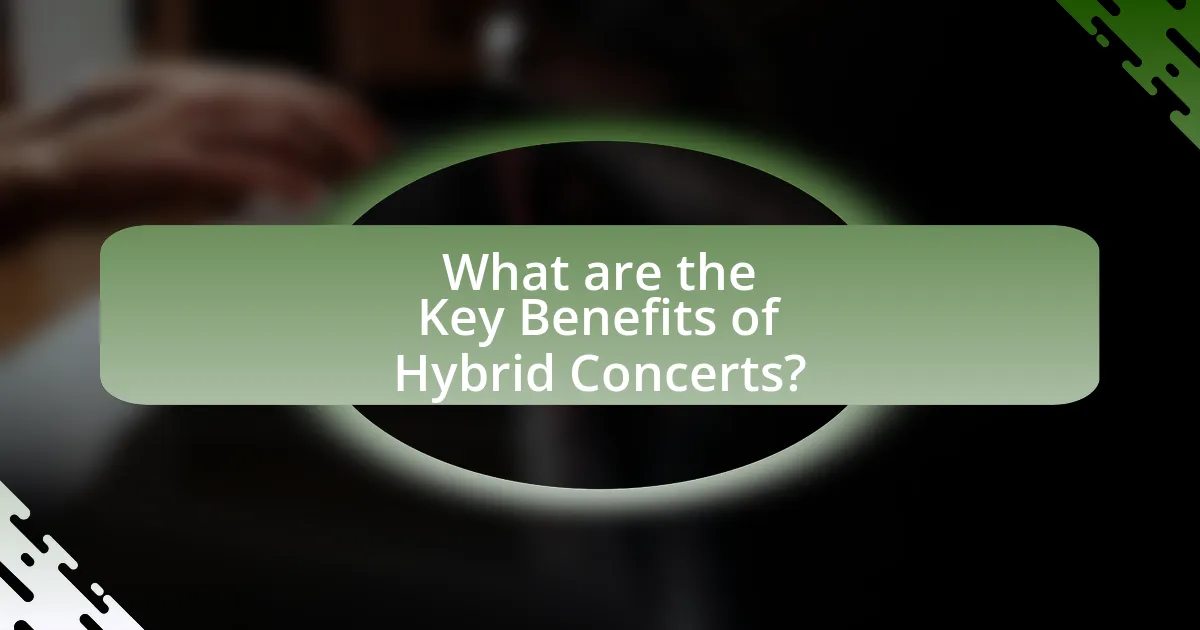
What are the Key Benefits of Hybrid Concerts?
Hybrid concerts provide the key benefits of increased accessibility, enhanced audience engagement, and expanded reach. By combining live and virtual elements, hybrid concerts allow fans who cannot attend in person to participate remotely, thus broadening the audience base. According to a report by Eventbrite, 67% of event organizers noted that hybrid formats increased ticket sales by reaching a wider demographic. Additionally, hybrid concerts facilitate interactive experiences through live streaming, enabling real-time audience participation via social media and chat features, which enhances overall engagement. This model not only caters to diverse audience preferences but also adapts to changing circumstances, such as health restrictions, ensuring that live music continues to thrive.
How do Hybrid Concerts expand audience reach?
Hybrid concerts expand audience reach by combining in-person attendance with virtual streaming, allowing access to a broader demographic. This format enables fans who cannot attend physically due to geographical, financial, or health constraints to participate in real-time. For instance, a study by the International Federation of the Phonographic Industry (IFPI) reported that 70% of music listeners are open to attending virtual events, indicating a significant potential audience. Additionally, hybrid concerts can leverage social media and online platforms to promote events, further increasing visibility and engagement.
What demographics are most attracted to Hybrid Concerts?
Young adults aged 18 to 34 are the demographics most attracted to hybrid concerts. This age group is particularly drawn to the combination of live and virtual experiences, as they are tech-savvy and value the flexibility that hybrid formats offer. According to a survey by Eventbrite, 70% of millennials and Gen Z attendees expressed interest in attending hybrid events, highlighting their preference for accessible and innovative concert experiences.
How do Hybrid Concerts cater to global audiences?
Hybrid concerts cater to global audiences by combining in-person attendance with virtual streaming options, allowing fans from various locations to participate. This format expands accessibility, enabling individuals who cannot travel to the venue to experience the performance in real-time. For instance, during the COVID-19 pandemic, artists like Travis Scott hosted hybrid concerts on platforms such as Fortnite, attracting millions of viewers worldwide, demonstrating the potential reach of hybrid events. Additionally, hybrid concerts often utilize multiple camera angles and interactive features, enhancing the viewing experience for online audiences and fostering a sense of community among fans regardless of their geographical location.
What unique experiences do Hybrid Concerts offer to attendees?
Hybrid concerts offer attendees a unique blend of live and virtual experiences, allowing for greater accessibility and engagement. These events enable fans to participate in real-time performances from anywhere in the world, breaking geographical barriers. For instance, a study by the International Music Summit in 2021 highlighted that hybrid concerts increased audience reach by up to 300%, allowing artists to connect with a global fanbase. Additionally, attendees can enjoy interactive features such as live chats, virtual meet-and-greets, and exclusive behind-the-scenes content, enhancing their overall experience. This combination of in-person and digital elements creates a more immersive and personalized atmosphere for concert-goers.
How do interactive features enhance the Hybrid Concert experience?
Interactive features significantly enhance the Hybrid Concert experience by fostering real-time engagement between artists and audiences. These features, such as live polls, chat functions, and virtual meet-and-greets, allow attendees to participate actively, creating a sense of community and connection that transcends physical boundaries. For instance, a study by the International Journal of Arts Management found that concerts incorporating interactive elements saw a 30% increase in audience satisfaction compared to traditional formats. This engagement not only enriches the viewer’s experience but also provides artists with immediate feedback and a deeper understanding of their audience’s preferences.
What feedback have attendees provided about Hybrid Concerts?
Attendees have provided positive feedback about Hybrid Concerts, highlighting their ability to combine the excitement of live performances with the convenience of virtual access. Many participants appreciate the flexibility of attending from home while still feeling connected to the event, as evidenced by a survey conducted by Eventbrite in 2022, which found that 70% of respondents enjoyed the option to choose between in-person and online attendance. Additionally, attendees have noted that Hybrid Concerts allow for greater accessibility, enabling fans from different geographical locations to participate, which was emphasized in a report by the International Live Music Conference, stating that 65% of virtual attendees felt included in the experience despite not being physically present.
How do Hybrid Concerts support artists and performers?
Hybrid concerts support artists and performers by expanding their audience reach and providing additional revenue streams. These events combine live in-person performances with virtual streaming, allowing artists to engage with fans who may not be able to attend physically. For instance, a study by Eventbrite in 2021 indicated that hybrid events can increase attendance by up to 30%, as they cater to both local and global audiences. This model not only enhances visibility for artists but also enables them to monetize their performances through ticket sales for both in-person and online viewers, thus diversifying their income sources.
What opportunities do Hybrid Concerts create for emerging artists?
Hybrid concerts create significant opportunities for emerging artists by expanding their audience reach and providing diverse revenue streams. These events allow artists to perform live while simultaneously streaming to online platforms, thus attracting both local attendees and global viewers. According to a report by Eventbrite, hybrid events can increase audience size by up to 300%, enabling artists to connect with fans who may not be able to attend in person. Additionally, hybrid concerts facilitate collaborations with other artists and brands, enhancing visibility and networking potential. This model also allows for innovative merchandising opportunities, as artists can sell digital tickets and exclusive online content, further diversifying their income sources.
How can artists monetize their performances through Hybrid Concerts?
Artists can monetize their performances through hybrid concerts by combining ticket sales for both in-person and virtual attendance, thus expanding their audience reach. This model allows artists to charge for physical tickets while also offering streaming access for a fee, which can significantly increase overall revenue. For instance, a study by Eventbrite found that hybrid events can attract up to 10 times more attendees than traditional live events alone, enhancing potential earnings. Additionally, artists can leverage merchandise sales during hybrid concerts, promoting exclusive items to both live and online audiences, further boosting income.
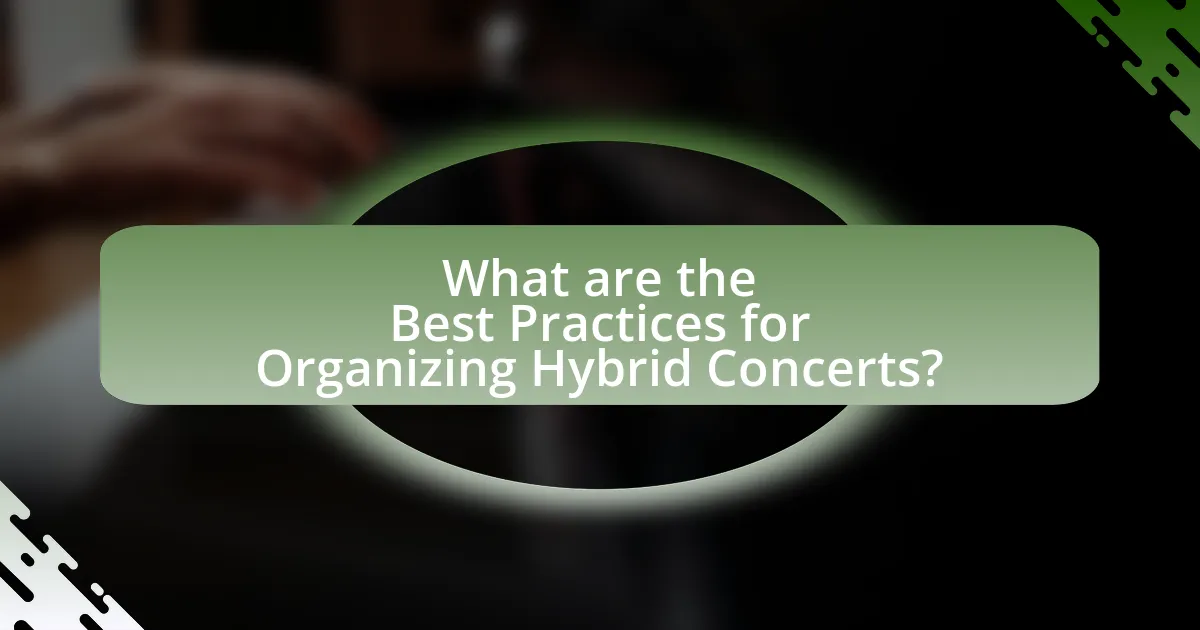
What are the Best Practices for Organizing Hybrid Concerts?
The best practices for organizing hybrid concerts include ensuring high-quality audio and video production, engaging both in-person and virtual audiences, and utilizing reliable technology platforms. High-quality production is essential to create an immersive experience; for instance, using multiple cameras and professional sound equipment can enhance the viewing experience for online attendees. Engaging both audiences can be achieved through interactive elements such as live chats, polls, and social media integration, which foster a sense of community. Additionally, selecting a reliable technology platform, such as Zoom or YouTube Live, ensures a seamless experience for virtual attendees, minimizing technical issues that could disrupt the event. These practices are supported by industry trends indicating that hybrid events can increase audience reach and engagement, as evidenced by a report from Eventbrite showing that 67% of event organizers plan to continue offering hybrid options post-pandemic.
How can organizers effectively market Hybrid Concerts?
Organizers can effectively market hybrid concerts by leveraging targeted digital marketing strategies that engage both in-person and virtual audiences. Utilizing social media platforms, such as Instagram and Facebook, allows organizers to create buzz through teasers, behind-the-scenes content, and interactive posts that encourage audience participation. Additionally, partnerships with influencers and music bloggers can amplify reach, as they can share promotional content with their followers, increasing visibility.
Email marketing campaigns targeting existing fan bases can also be effective, providing exclusive content and early access to tickets. According to a study by HubSpot, personalized email marketing can increase engagement rates by up to 29%. Furthermore, offering tiered ticket options that cater to both live attendees and virtual viewers can enhance accessibility and appeal to a broader audience.
Incorporating unique features, such as virtual meet-and-greets or exclusive online content, can further entice potential attendees. A report from Eventbrite indicates that 70% of event organizers believe that hybrid events will be a permanent fixture in the industry, highlighting the importance of adapting marketing strategies to this evolving landscape.
What strategies can be used to engage both live and virtual audiences?
To engage both live and virtual audiences, organizers can implement interactive technologies such as live polling and Q&A sessions. These strategies allow real-time participation, fostering a sense of community among attendees regardless of their location. For instance, platforms like Slido and Mentimeter enable audience members to submit questions or vote on topics, creating an inclusive environment. Additionally, utilizing high-quality streaming services ensures that virtual participants experience the event as vividly as those present in person, enhancing overall engagement. Research indicates that events incorporating interactive elements see a 30% increase in audience participation, demonstrating the effectiveness of these strategies.
How important is audience feedback in planning future Hybrid Concerts?
Audience feedback is crucial in planning future Hybrid Concerts. It provides insights into audience preferences, engagement levels, and overall satisfaction, which are essential for enhancing the concert experience. For instance, a survey conducted by Eventbrite in 2021 revealed that 70% of attendees preferred a mix of live and virtual elements, indicating a strong demand for hybrid formats. By analyzing this feedback, organizers can tailor their offerings to better meet audience expectations, ensuring higher attendance and improved experiences in subsequent events.
What technical considerations should be addressed for Hybrid Concerts?
Technical considerations for hybrid concerts include reliable internet connectivity, high-quality audio and video equipment, and effective streaming platforms. Reliable internet is crucial to ensure seamless transmission of live performances to virtual audiences, as disruptions can lead to a poor viewing experience. High-quality audio and video equipment is necessary to capture the nuances of live performances, ensuring that both in-person and online attendees receive an immersive experience. Effective streaming platforms must support interactive features, allowing virtual audiences to engage with the performance, which enhances the overall experience. These considerations are essential for successfully blending live and virtual concert experiences.
How can sound and video quality be optimized for Hybrid Concerts?
To optimize sound and video quality for hybrid concerts, employing high-quality audio equipment and advanced video technology is essential. Utilizing professional-grade microphones, mixers, and speakers ensures clear sound transmission to both in-person and virtual audiences. Additionally, implementing high-definition cameras and reliable streaming software enhances video clarity and reduces latency, providing a seamless experience for remote viewers. Research indicates that using a dedicated audio-visual team can significantly improve the overall production quality, as they can manage sound levels and video feeds in real-time, ensuring synchronization between live and streamed elements.
What equipment is essential for a successful Hybrid Concert setup?
A successful Hybrid Concert setup requires essential equipment including high-quality audio and video systems, reliable internet connectivity, and interactive streaming platforms. High-quality audio systems ensure that both in-person and virtual audiences experience clear sound, while advanced video systems, such as multiple cameras and live streaming software, capture and broadcast the performance effectively. Reliable internet connectivity is crucial to maintain a stable stream for online viewers, and interactive streaming platforms facilitate audience engagement through features like chat and polls. These components collectively enhance the concert experience, making it accessible and enjoyable for both live and virtual attendees.
What are common pitfalls to avoid when organizing Hybrid Concerts?
Common pitfalls to avoid when organizing hybrid concerts include inadequate technology planning, lack of audience engagement strategies, and insufficient promotion. Inadequate technology planning can lead to technical failures during the event, which can disrupt both live and virtual experiences. For instance, a survey by Eventbrite found that 30% of event organizers faced technical issues during hybrid events, highlighting the importance of thorough testing and reliable equipment. Lack of audience engagement strategies can result in a disconnection between in-person and virtual attendees, diminishing the overall experience. Engaging both audiences through interactive elements, such as live polls or Q&A sessions, is crucial. Lastly, insufficient promotion can lead to low attendance, as hybrid concerts require targeted marketing to reach both local and online audiences effectively. According to a report by Statista, 70% of successful hybrid events had a comprehensive marketing plan, emphasizing the need for strategic outreach.
How can organizers ensure a seamless experience for both live and virtual attendees?
Organizers can ensure a seamless experience for both live and virtual attendees by implementing integrated technology solutions that facilitate real-time interaction and engagement. Utilizing high-quality streaming services, such as those that support low latency and high-definition video, allows virtual attendees to feel present in the event. Additionally, incorporating interactive features like live polls, Q&A sessions, and chat functions fosters engagement among both audiences.
Research indicates that events utilizing hybrid models with interactive technology report higher satisfaction rates, with a study by Eventbrite showing that 70% of attendees prefer events that offer both in-person and virtual options. This approach not only enhances the experience for virtual participants but also allows live attendees to engage with remote viewers, creating a more inclusive atmosphere.
What contingency plans should be in place for Hybrid Concerts?
Contingency plans for hybrid concerts should include technical support, health and safety protocols, and communication strategies. Technical support ensures that both live and virtual components function seamlessly, addressing potential issues with streaming or sound equipment. Health and safety protocols must comply with local regulations, including crowd management and sanitation measures, to protect in-person attendees. Communication strategies should involve clear messaging to inform both live and virtual audiences about any changes or updates, ensuring that all participants remain engaged and informed throughout the event.
What are the key takeaways for successfully implementing Hybrid Concerts?
Key takeaways for successfully implementing hybrid concerts include ensuring high-quality audio and visual production, engaging both in-person and virtual audiences, and utilizing effective technology platforms. High-quality production is essential, as it enhances the experience for both live attendees and online viewers, with studies showing that superior audio-visual quality significantly increases audience satisfaction. Engaging both audiences can be achieved through interactive features such as live chats, polls, and social media integration, which have been shown to boost participation and connection. Finally, selecting reliable technology platforms that can handle streaming and audience interaction seamlessly is crucial, as technical failures can detract from the overall experience and lead to audience disengagement.
